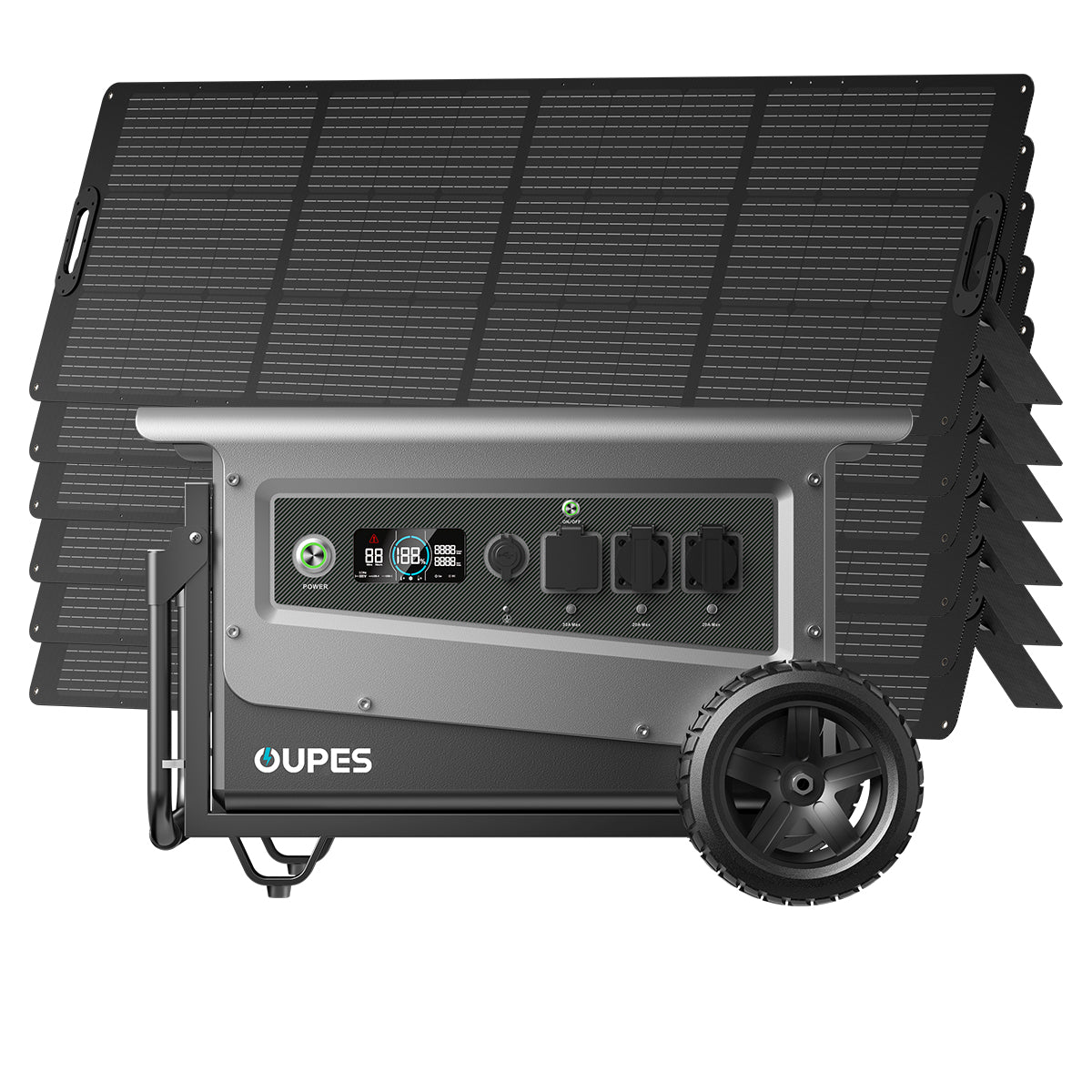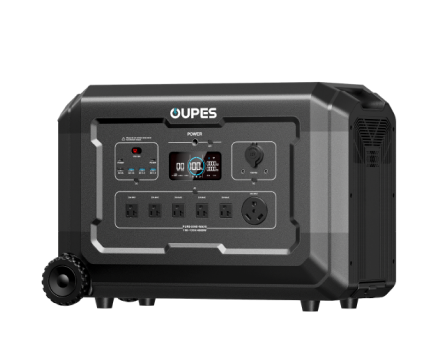
When the grid goes dark for days—not hours—your plan, gear, and habits decide whether life simply slows down or grinds to a halt. This guide is scenario-oriented, rooted in real-world use, and focused on building a reliable, layered backup system with OUPES power solutions.
TL;DR / Key Takeaways
- List your critical loads (fridge, communications, medical, work gear) and estimate daily watt-hours.
- Build layers: silent indoor battery power → solar recharging → optional top-up generator for no-sun days.
- Right-size with OUPES: Exodus for portability; Mega Series or Titan 5 for whole-home/rugged needs; expand with B-series batteries.
- Practice your setup twice a year and store essential non-electric supplies (water, food, meds, light).
Why “Long-Term” Needs a Different Plan
Storms, heatwaves, wildfires, grid maintenance, and ice events can cause multi-day outages. Short outages are about convenience; long outages threaten food safety, security systems, remote work, medical devices, and comfort. The solution is a layered energy plan that keeps high-priority loads powered continuously and refuels itself without waiting for the grid.
Step 1 — Map Your Critical Loads
What matters in the first 72 hours
- Cold chain: refrigerator/freezer (prevent spoilage, avoid waste)
- Health & safety: medical devices (per manual), CPAP/EPS, small space-heating fans or heated blankets, phones/radios
- Work & communication: laptop, modem/router, phone chargers, LED lighting
- Comfort & essentials: coffee maker/kettle (brief high draw), induction hotplate (occasional), low-draw entertainment
Estimate your daily energy need
Use this simple approach: Daily Watt-hours ≈ Sum of (Device Watts × Hours Used). Add a 20–30% buffer for inverter overhead and unexpected use. For example, a 150W fridge averaging 8 hours of runtime is ~1,200Wh/day; a 60W router running 24 hours is ~1,440Wh/day.
| Typical Load | Power (W) | Hours/Day | Daily Use (Wh) | Notes |
|---|---|---|---|---|
| Refrigerator (modern) | 100–200 | 6–12 (duty cycle) | 600–2,400 | Opens less = lower use |
| Wi-Fi router + modem | 15–30 | 24 | 360–720 | Critical for comms/work |
| Laptop | 40–80 | 4–8 | 160–640 | Power-save modes help |
| LED lights (4 bulbs) | 24–40 | 5 | 120–200 | Use task lighting |
| CPAP (no humidifier) | 30–60 | 8 | 240–480 | Check device manual |
| Phone charging (2x) | 5–10 | 2 | 10–40 | Charge mid-day on solar |
Tip: Start with essentials only. You can add non-essentials later if your system has headroom.
Step 2 — Build a Layered Backup System
A resilient setup has three layers:
- Silent indoor battery power station for immediate, safe, fume-free energy.
- Solar input to recharge daily and stretch your autonomy indefinitely.
- Optional fuel generator to top up during extended bad weather or heavy use.
OUPES power solutions at a glance
| Model | Rated Output | Base Energy | Expandability | Notable Features | Best For |
|---|---|---|---|---|---|
| Exodus 1200 | 1200W (1500W boost) | — (compact portable) | — | Dual 140W USB-C, EPS <20ms, 10 ports, ~23 lbs, 3500 cycles, Smart App, 600W AC / 240W solar / 840W AC+Solar | Apartments, essential loads, travel |
| Mega 3 | 3600W (7000W surge) | 3.072kWh | Up to 15.36kWh (with six B2 units) | 16 output ports; four charging modes; up to 3900W (1800W AC + 2100W solar) for ~0.8h fast charge | Home backup, RV, heavy tools |
| Mega 5 | 4000W (7000W surge) | — (home-class) | Up to 45.36kWh (with B-series) | Seamless UPS backup (2100W max), 3900W AC+Solar fast charge (~1.3h), up to 16 ports, color LCD | Whole-home resilience |
| Titan 5 | 4000W | 5kWh | Compatible with B5 for large expansions | Rugged 5kWh base; ideal for extended outages with extra batteries | Long outages, workshops, job sites |
| B2 Extra Battery | Standalone outputs | — (modular) | High solar intake (up to 2100W) | Operates independently; ports: 1×Anderson (12V/30A), 2×DC5521, 1×Car Lighter (12V/10A), 2×USB-C (100W ea), 4×USB-A (18W); solar-only full charge in ~1.2h | RV/field work, flexible expansion |
| B5 Extra Battery | — | — | Expands Mega 5 / Titan 5 up to 45.36kWh | EV-grade LiFePO4, ~3500 cycles, 10-year lifespan | Multi-day home outages |
| 240W Solar Panel | — | — | Pairs with OUPES stations | Up to 20% efficiency, ETFE multi-layer protection, MC4 connector | Daily recharging, off-grid trips |
| E1600 Gas Generator | Top-up charging source | — | Designed to charge OUPES stations | 4L tank; when used to intermittently recharge OUPES power stations, it can support backup needs for up to 20 days in extended outages | No-sun days, night charging |
Why layers? Battery stations handle continuous, indoor-safe usage; solar extends autonomy indefinitely in good weather; an occasional generator top-up bridges cloudy stretches or heavier-than-usual loads.
Step 3 — Scenario Playbooks
Apartment / Condo (limited space, neighbors)
- Goal: Keep fridge cold, run internet/phones, and sleep safely with CPAP.
- Recommended: OUPES Exodus 1200 + 240W Solar Panel on a balcony/patio (where permitted).
- Why: Portable, quiet, fast AC recharge when power briefly returns, flexible solar top-ups mid-day.
- Tips: Shift heavy charging (laptops, power banks) to solar hours; use ice packs to stabilize fridge temps; avoid high-draw cooking—opt for insulated cooking or batch boiling mid-day.
Suburban Home (family, multiple devices)
- Goal: Keep refrigerator/freezer, lighting, network, key outlets, and select appliances running for days.
- Recommended: OUPES Mega 5 or Titan 5 + B5 extra batteries; rooftop or ground-deployed 240W solar arrays; optional E1600 for no-sun periods.
- Why: 4000W output covers most household circuits and startup surges; expansion to 45.36kWh supports multi-day autonomy.
- Tips: Use the Mega 5’s seamless UPS (2100W max) for computers and networking; schedule chores (laundry, vacuum, cooking) when solar harvest peaks.
RV / Off-Grid Cabin (mobility & space efficiency)
- Goal: Energy independence for lights, fans, DC appliances, cameras, and tools.
- Recommended: Mega 3 + B2 Extra Battery (standalone outputs) + multiple 240W panels.
- Why: 3600W output handles power tools and small AC units; B2 accepts up to 2100W solar and can operate independently.
- Tips: Hard-mount panels where possible; keep cables short; park for optimal sun; rotate panels seasonally.
Home Office / Small Business Continuity
- Goal: Protect income by keeping routers, NAS, workstations, and task lighting online.
- Recommended: Mega 5 (UPS) for seamless switchover; add B5 batteries for multi-day runtime; optional E1600 for extended bad weather.
- Why: UPS function prevents data loss; fast AC+solar charging restores capacity quickly between rolling outages.
Step 4 — Operating Strategy During a Multi-Day Outage
Daily routine
- Morning: Quick status check on your OUPES LCD/app; defer high-draw tasks.
- Mid-day (solar peak): Run charging-intensive tasks (laptops, power banks) and short, high-draw appliances.
- Evening/night: Switch to low-draw lighting and fan settings; pre-charge phones before sunset.
Fridge & freezer best practices
- Keep doors closed; group openings.
- Freeze water bottles for thermal mass.
- Use a thermometer; keep fridge ≤4 °C (≤40 °F), freezer at −18 °C (0 °F).
Generator safety (if using E1600)
- Operate outdoors only, far from doors/windows; never in garages.
- Store fuel safely; let unit cool before refueling.
- Use it to recharge your OUPES station during the day to reduce noise impact.
Step 5 — Non-Electric Essentials
- Water: 4 L (1 gal) per person per day; add purification tablets/filters.
- Food: Shelf-stable items; manual can opener; insulated cooker/thermal pot.
- Lighting: Headlamps/lanterns with rechargeable batteries (charge via OUPES USB).
- Medications & documents: 7–14 days supply; keep copies in a dry bag.
- Communication: Whistle, basic radio, printed emergency contacts.
How to Right-Size Your OUPES Setup
Quick selection guide
| Daily Need (Wh) | Use Case | Recommended OUPES Setup | Why It Works |
|---|---|---|---|
| 800–1,800 | Apt essentials, CPAP, Wi-Fi, lights | Exodus 1200 + 240W Solar Panel | Portable; fast AC/solar recharge; EPS <20ms keeps electronics steady |
| 2,000–4,000 | Fridge, networking, laptop, lights | Mega 3 (3.072kWh) + 240–480W solar | 3600W output covers surges; fast hybrid charging; expandable storage |
| 4,000–8,000+ | Whole-home essentials for multi-day | Mega 5 or Titan 5 + B5 batteries + solar; optional E1600 | 4000W output; expand up to 45.36kWh; UPS on Mega 5 protects critical circuits |
Note: For medical devices, always consult the device manual for exact power needs and compatibility.
Maintenance & Readiness Checklist
Every 3–6 months
- Top off your OUPES stations to 80–100% and cycle them under a typical load.
- Lay out and test solar panels; inspect cables and MC4 connectors.
- If you use the E1600, run it briefly outdoors and refresh fuel safely.
- Update a printed load list and your drill script (who does what, in what order).
Outage-day drill
- Power critical circuits via your OUPES station (Mega 5 UPS enables seamless switchover up to its UPS limit).
- Deploy solar by 9–10 AM; aim panels at the sun; check input wattage.
- Batch high-draw tasks at solar peak; log energy in/out on the LCD/app.
- Use E1600 sparingly to top up during poor weather or after several cloudy days.
Frequently Asked Questions
How long can OUPES run a refrigerator?
It depends on the model and the fridge’s actual draw. As a rough guide, a modern fridge averaging ~1,200Wh/day can be supported for multiple days with a Mega 3 or larger system, especially when paired with daily solar recharging. Limit door openings and cool hot foods before storing.
Can I run sensitive electronics like desktops and NAS?
Yes. OUPES stations provide clean sine-wave power. Use the Mega 5’s seamless UPS (up to 2100W) to prevent interruptions during grid switchover.
Is solar really enough for long outages?
In many climates, yes—if you size panels for your daily need and plan usage around mid-day harvesting. Keep an E1600 or extra battery capacity as a weather hedge.
How do the B2 and B5 extra batteries fit in?
B2 can operate independently with its own output ports and accepts up to 2100W solar—excellent for RVs and flexible setups. B5 expands Mega 5 or Titan 5 capacity, enabling up to 45.36kWh for true multi-day home backup.
Are OUPES batteries safe for indoor use?
Yes—OUPES stations use EV-grade LiFePO4 cells with high cycle life (around 3500 cycles) and a secure BMS. Operate the E1600 generator outdoors only.
What’s the fastest way to recharge?
Combine AC and solar when available. Mega 5 supports up to 3900W AC+Solar for roughly 1.3-hour full charges; Mega 3 can reach ~0.8-hour fast charging with 1800W AC + 2100W solar. Exodus 1200 supports 600W AC, 240W solar, or 840W hybrid.
Final Word
Preparedness is a habit. Start with a realistic load map, choose an OUPES system that fits your daily energy need, and rehearse your routine. With a layered battery-solar-generator strategy, even a week-long outage can become a manageable inconvenience rather than a crisis.




























